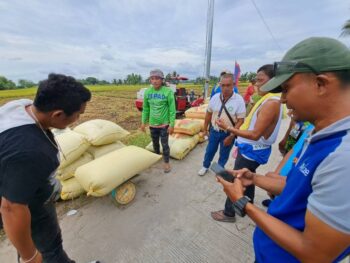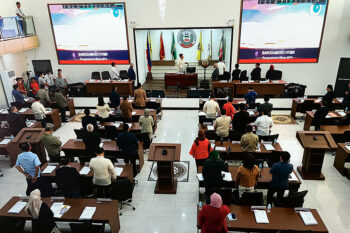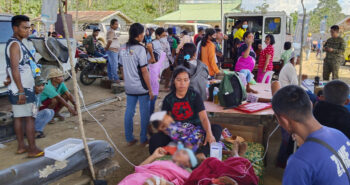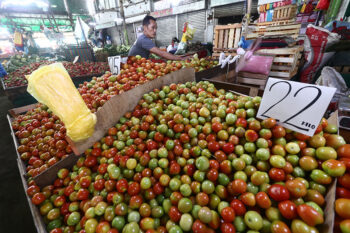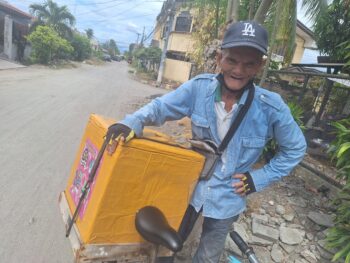ILIGAN CITY (MindaNews / 03 July) – The year was 1966, the last quarter. I cannot place the exact date now but it was definitely before the end of December. I received a telegram (yes, it was still the age of the telegram!), asking me to report to Notre Dame of Jolo College in January. So, in the first week of January 1967, I took the DC-3 Philippine Airlines (PAL) plane from the Cotabato airport in Awang (it is now called Awang airport in Datu Odin Sinsuat municipality). It proceeded to Jolo after a brief stopover in Zamboanga City. I traveled light. I was supposed to fly the day before and had actually checked in.
But I was so busy chatting and saying goodbye to friends outside the pre-departure area of the unfinished airport building that I did not realize, nobody did, that passengers had been called for boarding. The plane’s engine was revving up and I actually saw at the corner of my eyes the aircraft’s door closing on me.
Safe and intact, my luggage was waiting for me in Jolo when I landed the following day. [Today, the era of bomb scares, the absence of a checked-in passenger is sufficient reason for the pilot to hold the flight until his luggage is unloaded.]
Apprehensive, some of my friends had asked: why would I go to Jolo? Christians who go there leave without their heads, they said. Smiling innocently, I said I would go and see for myself. I stayed there three semesters and one summer.
The Jolo that I lived in and experienced in the next one year and a half was not conflict-free, conflict with students, conflict with colleagues, faculty and staff, and conflict with administrators. But these did not dominate my life. On the whole, despite the conflicts, I consider Jolo as my best experience in living among Muslims.
My first major conflict was when my Philippine history students, mostly Tausug, vehemently and agitatedly objected to my use of the phrase “Moro pirates.” I cannot recount the details of their individual discourses now but in essence this was their message to me: their ancestors were not pirates; they were at war with the Spaniards; they also had to fight the latter’s Filipino Christian allies. And that war lasted throughout the stay of the colonizers, 333 years. For more than thirty minutes I listened in silence, speaking only to acknowledge the next student who intensely wanted to speak. They stood up, one after the other, each saying his piece, loud, angry and assertive. It was their history.
Unable to interrupt I was surprised that I maintained my cool through that sustained barrage. It was a humbling experience. While I acknowledged their version of their history, I confessed that the details of these had not seen print, certainly not in the only material in my academic arsenal at that time, Dr. Gregorio Zaide’s Philippine Political and Cultural History (1957), Volumes I and II.
It would not be until 1973, when Dr. Cesar Majul’s monumental book, Muslims in the Philippines, would come out of the press, that the overwhelming details of their version would be properly acknowledged. I saved my dignity by saying that their version of history was not yet in the books, so would it be alright with them if we moved on. They agreed. The bell rang. What a baptism of fire!
Not being a history major, that experience may have subtly driven me to go into history for my MA. Now I am a Mindanao historian and would not make that mistake again.
My next major conflict was when a charming lady teacher from Luzon, a first timer in Jolo and had never been out of Luzon until that time, refused to dance with daring young male Tausug students during the college student acquaintance party. Dancing with her would have been a great honor for any male student. Her reason was that where she came from female teachers did not dance with their male students.
No, I was not a party to the conflict. I happened to be the fraternity’s faculty adviser and the student leaders who wanted to kidnap her for that affront were frat members and I was the closest friend the teacher had at that time. They were not allowing themselves to be insulted in their own place by an outsider; her belonging to another culture was no excuse. I played mediator.
In my dialogue with them, which took several meetings, long enough for their sense of righteous anger to cool down, they agreed to give her another chance. The organization would host a frat party, formal, coat and tie, the town mayor would be there, the college rector, too, and the lady teacher; the ladies would come in gowns. The fratmen would invite their own partners.
It was my task as faculty adviser to escort her to the party. That night, in total darkness – because dances then were done in total darkness, not even candle light was allowed – all the frat members got to dance with her. From that night on until her departure the following year, the boys saw to it that she was safe.
My third major conflict was not really mine. A massive student mass action was triggered by the college administration’s refusal to publish the lampoon issue of the school paper where, among others, the rector, a priest, was depicted under the skirt (saya) of the lady college dean. The editor-in-chief was called to the rector’s office and emerged trembling, pale and in cold sweat.
We, the young teachers, eight of us, met with the student leaders several times and tried to reason with them. But this was not the way the administration perceived the effort; we were seen as the agitators.
The plan was to boycott the recognition night, the time when medals and all honors were awarded formally before Jolo’s 400, the cream of the Jolo community. They agreed not to boycott. They would come but if the top medalist did not go up the stage, the others would follow. That night the top medalist received his medals and the others followed.
But the students clapped their hands in unison throughout the awarding ceremonies, not the clap of applause but in cadence, one clap per second, obviously meant to disrupt the event.
The audience each received a copy of the main article of the lampoon issue of the banned school paper. No student was expelled. My contract was not renewed. I still have my head.
Those months of real life experience in Jolo has taught me so much about Tausug sensibilities. His sense of honor has very deep roots in his history and culture. He is sensitive, he is generous, he is even willing to offer his life for a friend.
One of the unfortunate realities of our educational system is that our Philippine history books do not reflect the core realities of Mindanao history in general and Moro history in particular. Our Philippine history has not appropriately acknowledged Moro history.
So we should not be surprised that Moro struggle for self-determination continues to live on.
(MindaViews is the opinion section of MindaNews. Rudy Buhay Rodil is a Mindanao historian and member of the government peace panel that negotiated with the Moro National Liberation Front (1993-1996) and with the Moro Islamic Liberation Front from August 2004 until the panel’s dissolution on September 3, 2008).


